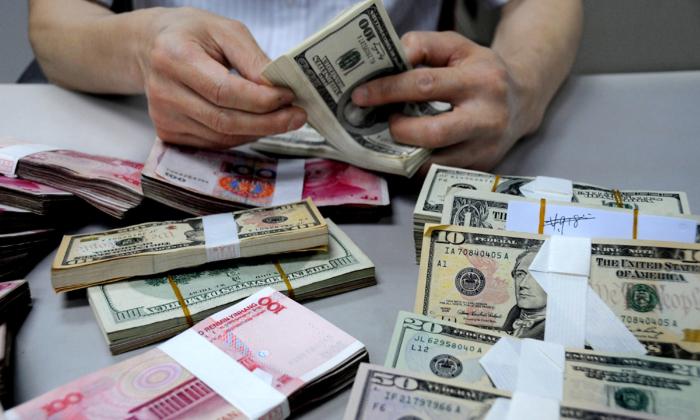After the U.S. Securities and Exchange Commission (SEC) tightened its supervision of China concept stocks and U.S.-China relations worsened further following the outbreak of the Russian-Ukrainian war, foreign investment into China has plummeted by more than 60 percent in the first quarter of 2022 compared to the same period last year.
According to the latest quarterly report by the Zero2IPO Research Center, a top venture capital and private equity research firm in China, in the first quarter of 2022, a total of 20 foreign currency funds in China’s equity investment market raised about 31.5 billion yuan ($4.8 billion)—a sharp decrease of over 60 percent from the first quarter of 2021.
Among these foreign currency funds, Gaorong Capital’s USD Fund phase-6 raised $1.85 billion; Tiger Global Private Equity Fund phase-15 raised $1.12 billion; Blackstone Asia Acquisition Fund phase-2 raised $790 million; Huaxing New Economy’s USD fund phase-4 raised $250 million; and Weilai Capital’s USD fund phase-2 raised $226 million.
China’s equity investment market segments include early-stage investment, venture capital (VC), and private equity (PE), with VC and PE accounting for a predominant proportion. Both VC and PE funds usually choose to invest in companies with the highest potential in the next couple of years. If the IPO encounters any unexpected problems, fund liquidation is very difficult.
The latest statistics from Zero2IPO show that, in the first quarter of 2022, the overall performance of Chinese companies going public overseas was at a historical low. Specifically, the popularity of IPOs in Hong Kong stocks continued to decline, and only one Chinese company was listed on U.S. stock exchange.
During this period, only 12 Chinese companies were listed on the Hong Kong stock exchange, raising a total capital of approximately $1.4 billion. The number of Hong Kong IPOs dropped by about 50 percent when compared with Q1 or Q4 of 2021, and the capital raised plummeted by 90 percent when compared with Q1 of last year.
On the U.S. stock exchange, Meihua International Medical Co., Ltd. went public on the Nasdaq in February this year, raising capital totaling roughly $35.5 million. This is in stark contrast to the fiery situation of China concept stocks that went public in the United States in the first quarter of last year. In the first three months of last year, excluding the SPAC (special purpose acquisition company) and OTC (over-the-counter) markets, 20 Chinese companies went public in the United States, raising nearly $4.2 billion. Of these, 14 were listed on the Nasdaq and six on the New York Stock Exchange.
Zero2IPO believes that the U.S. Securities and Exchange Commission’s (SEC) tightened supervision of China concept stocks going public in the United States has led to the sharp decline.
In early December last year, Chinese ride-hailing giant Didi announced that it would delist from the New York stock exchange and pursue a listing in Hong Kong. Then, on Dec. 20, 2021, the SEC released new guidance demanding greater disclosure from Chinese companies listing on U.S. stock exchanges, requiring that Chinese companies that operate under variable interest entity (VIE) schemes to raise their funds provide “clear and prominent” information about their structure and the associated risks.
After the SEC suspended the IPOs of Chinese companies in the United States following the delisting of Didi, some U.S. dollar funds found themselves in an embarrassing situation, as they had great difficulty exiting their existing investments in Chinese companies.
According to data from Zero2IPO, Chinese internet start-ups completed at least 23 equity financings in August last year, yet none were in U.S. dollars.
Accelerated Withdrawal of Foreign Capital
After Russia’s invasion of Ukraine in February, capital outflows from Chinese stocks and bonds accelerated. Some investors worry that China’s pro-Russian stance could make China more prone to political and economic risks.In March this year, U.S. National Security Adviser Jake Sullivan warned that China will “absolutely” face consequences if it helps Russia evade sanctions over its invasion of Ukraine.
According to U.S. law, if a company’s business dealings involve countries, companies, or individuals sanctioned by the United States, it faces being subject to secondary sanctions.
A report released on April 5 by the Institute of International Finance (IIF) stated that in March, China’s foreign portfolio outflows came to $11.2 billion in bonds and $6.3 billion in stocks. The IIF described this as an “unprecedented dynamic,” suggesting a market rotation away from China.
At the same time, China’s stubborn adherence to its “zero-COVID” policy to curb the latest outbreaks of Omicron have further deteriorated the economic environment.
UBS Investment Bank recently lowered its forecast for China’s domestic product growth this year to 4.2 percent from 5.0 percent, as China’s largest city Shanghai has been placed under prolonged COVID lockdown, with lockdowns expanding to other cities.





